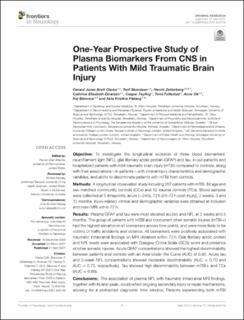| dc.contributor.author | Clarke, Gerard Janez Brett | |
| dc.contributor.author | Clarke, Gerard | |
| dc.contributor.author | Skandsen, Toril | |
| dc.contributor.author | Zetterberg, Henrik | |
| dc.contributor.author | Einarsen, Cathrine Elisabeth | |
| dc.contributor.author | Feyling, Casper Kongstein | |
| dc.contributor.author | Follestad, Turid | |
| dc.contributor.author | Vik, Anne | |
| dc.contributor.author | Blennow, Kaj | |
| dc.contributor.author | Håberg, Asta | |
| dc.date.accessioned | 2021-08-31T08:27:25Z | |
| dc.date.available | 2021-08-31T08:27:25Z | |
| dc.date.created | 2021-08-10T16:46:57Z | |
| dc.date.issued | 2021 | |
| dc.identifier.citation | Frontiers in Neurology. 2021, 12, 1-17. | en_US |
| dc.identifier.issn | 1664-2295 | |
| dc.identifier.uri | https://hdl.handle.net/11250/2771867 | |
| dc.description.abstract | Objective: To investigate the longitudinal evolution of three blood biomarkers: neurofilament light (NFL), glial fibrillary acidic protein (GFAP) and tau, in out-patients and hospitalized patients with mild traumatic brain injury (mTBI) compared to controls, along with their associations—in patients—with clinical injury characteristics and demographic variables, and ability to discriminate patients with mTBI from controls.
Methods: A longitudinal observation study including 207 patients with mTBI, 84 age and sex-matched community controls (CCs) and 52 trauma controls (TCs). Blood samples were collected at 5 timepoints: acute (<24 h), 72 h (24–72 h post-injury), 2 weeks, 3 and 12 months. Injury-related, clinical and demographic variables were obtained at inclusion and brain MRI within 72 h.
Results: Plasma GFAP and tau were most elevated acutely and NFL at 2 weeks and 3 months. The group of patients with mTBI and concurrent other somatic injuries (mTBI+) had the highest elevation in all biomarkers across time points, and were more likely to be victims of traffic accidents and violence. All biomarkers were positively associated with traumatic intracranial findings on MRI obtained within 72 h. Glial fibrillary acidic protein and NFL levels were associated with Glasgow Coma Scale (GCS) score and presence of other somatic injuries. Acute GFAP concentrations showed the highest discriminability between patients and controls with an Area Under the Curve (AUC) of 0.92. Acute tau and 2-week NFL concentrations showed moderate discriminability (AUC = 0.70 and AUC = 0.75, respectively). Tau showed high discriminability between mTBI+ and TCs (AUC = 0.80).
Conclusions: The association of plasma NFL with traumatic intracranial MRI findings, together with its later peak, could reflect ongoing secondary injury or repair mechanisms, allowing for a protracted diagnostic time window. Patients experiencing both mTBI and other injuries appear to be a subgroup with greater neural injury, differing from both the mTBI without other injuries and from both control groups. Acute GFAP concentrations showed the highest discriminability between patients and controls, were highly associated with intracranial traumatic injury, and showed the largest elevations compared to controls at the acute timepoint, suggesting it to be the most clinically useful plasma biomarker of primary CNS injury in mTBI. | en_US |
| dc.language.iso | eng | en_US |
| dc.publisher | Frontiers Media | en_US |
| dc.rights | Navngivelse 4.0 Internasjonal | * |
| dc.rights.uri | http://creativecommons.org/licenses/by/4.0/deed.no | * |
| dc.title | One-Year Prospective Study of Plasma Biomarkers From CNS in Patients With Mild Traumatic Brain Injury | en_US |
| dc.type | Peer reviewed | en_US |
| dc.type | Journal article | en_US |
| dc.description.version | publishedVersion | en_US |
| dc.source.pagenumber | 1-17 | en_US |
| dc.source.volume | 12 | en_US |
| dc.source.journal | Frontiers in Neurology | en_US |
| dc.identifier.doi | 10.3389/fneur.2021.643743 | |
| dc.identifier.cristin | 1925180 | |
| dc.description.localcode | Copyright © 2021 Clarke, Skandsen, Zetterberg, Einarsen, Feyling, Follestad, Vik, Blennow and Håberg. This is an open-access article distributed under the terms of the Creative Commons Attribution License (CC BY). The use, distribution or reproduction in other forums is permitted, provided the original author(s) and the copyright owner(s) are credited and that the original publication in this journal is cited, in accordance with accepted academic practice. No use, distribution or reproduction is permitted which does not comply with these terms. | en_US |
| dc.source.articlenumber | 643743 | en_US |
| cristin.ispublished | true | |
| cristin.fulltext | original | |
| cristin.qualitycode | 1 | |

